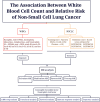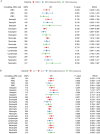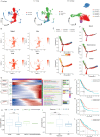The association between white blood cell count and relative risk of non-small cell lung cancer
- PMID: 40773084
- PMCID: PMC12332170
- DOI: 10.1007/s12672-025-03377-3
The association between white blood cell count and relative risk of non-small cell lung cancer
Abstract
Background: High abundance of eosinophils has been proved to associated with favorable disease progression in non-small cell lung cancer (NSCLC) in the previous observational studies, but the causal relationship remains unclear. It is also unclear whether white blood cell (WBC) counts are essential for the risk of NSCLC.
Methods: Using multiple methods of Mendelian randomization (MR), we assessed the causality of WBC count, particularly basophil, eosinophil, monocyte, lymphocyte, and neutrophil counts on the risk of NSCLC, which includes squamous carcinoma and adenocarcinoma. Single cell RNA-sequencing and RNA-sequencing analysis illustrate the underline mechanism of the causality and its biological effects.
Results: Univariable MR analysis indicated the protective effect of elevated eosinophil counts on NSCLC and adenocarcinoma subtype. The protective effect of eosinophils persisted even after adjusting. The protective functions mainly effected by immune activating, and it contribute to better survival and favorable response to immune therapy. Univariate MR analysis also states the risk role of neutrophil. Sequencing based analysis proved the immune inhibit functions of neutrophil, which lead to worse survival and immune treatment response.
Conclusion: Our study indicated a correlation between circulating eosinophil counts, neutrophil counts, and the development of NSCLC. And sequencing analysis confirm this relationship and illustrated the underline mechanism.
Keywords: Eosinophils; Mendelian randomization; NSCLC; Single-cell RNA sequencing; WBC.
© 2025. The Author(s).
Conflict of interest statement
Declarations. Competing interests: The authors declare no competing interests.
Figures




Similar articles
-
Bidirectional two-sample Mendelian randomization study of differential white blood cell counts and schizophrenia.Brain Behav Immun. 2024 May;118:22-30. doi: 10.1016/j.bbi.2024.02.015. Epub 2024 Feb 13. Brain Behav Immun. 2024. PMID: 38355025
-
Genetic Determinants of Leukocyte Count in Nonsyndromic Cleft Lip With or Without Cleft Palate Among Asians.Int Dent J. 2025 Jul 3;75(5):100877. doi: 10.1016/j.identj.2025.100877. Online ahead of print. Int Dent J. 2025. PMID: 40614465 Free PMC article.
-
[Volume and health outcomes: evidence from systematic reviews and from evaluation of Italian hospital data].Epidemiol Prev. 2013 Mar-Jun;37(2-3 Suppl 2):1-100. Epidemiol Prev. 2013. PMID: 23851286 Italian.
-
Intratumoral neutrophil-to-lymphocyte ratio is mirrored by circulating neutrophil-to-lymphocyte ratio in non-small cell lung cancer.J Immunother Cancer. 2025 Jun 24;13(6):e011458. doi: 10.1136/jitc-2025-011458. J Immunother Cancer. 2025. PMID: 40555561 Free PMC article.
-
Chemotherapy with cetuximab versus chemotherapy alone for chemotherapy-naive advanced non-small cell lung cancer.Cochrane Database Syst Rev. 2014 Nov 17;2014(11):CD009948. doi: 10.1002/14651858.CD009948.pub2. Cochrane Database Syst Rev. 2014. PMID: 25400254 Free PMC article.
References
Grants and funding
LinkOut - more resources
Full Text Sources
